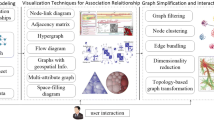Abstract
With the popularity of Web 2.0 sites, social networks today increasingly involve different kinds of relationships among different types of users in a single network. Such social networks are said to be multi-dimensional. Analyzing multi-dimensional networks is a challenging research task that requires intelligent visualization techniques. In this paper, we therefore propose a visual analytics tool called ViStruclizer to analyze structures embedded in a multi-dimensional social network. ViStruclizer incorporates structure analyzers that summarize social networks into both node clusters each representing a set of users, and edge clusters representing relationships between users in the node clusters. ViStruclizer supports user interactions to examine specific clusters of users and inter-cluster relationships, as well as to refine the learnt structural summary.
Access this chapter
Tax calculation will be finalised at checkout
Purchases are for personal use only
Preview
Unable to display preview. Download preview PDF.
Similar content being viewed by others
References
Airoldi, E.M., Blei, D.M., Fienberg, S.E., Xing, E.P.: Mixed membership stochastic blockmodels. Journal of Machine Learning Research 9, 1981–2014 (2008)
Batagelj, V., Mrvar, A.: Pajek - Analysis and Visualization of Large Networks. In: Mutzel, P., Jünger, M., Leipert, S. (eds.) GD 2001. LNCS, vol. 2265, pp. 477–478. Springer, Heidelberg (2002)
Cao, N., Sun, J., Lin, Y.R., Gotz, D., Liu, S., Qu, H.: Facetatlas: Multifaceted visualization for rich text corpora. IEEE Transactions on Visualization and Computer Graphics 16(6), 1172–1181 (2010)
Contractor, N.S.: The emergence of multidimensional networks. Journal of Computer-Mediated Communication 14(3), 743–747 (2009)
Dai, B.T., Chua, F.C.T., Lim, E.P.: Structural analysis in multi-relational social networks. In: SDM, pp. 451–462 (2012)
Dai, B.T., Lim, E.P., Prasetyo, P.K.: Topic discovery from tweet replies. In: MLG: The Workshop on Mining and Learning with Graphs (2012)
Heer, J., Boyd, D.: Vizster: Visualizing online social networks. In: INFOVIS, p. 5 (2005)
Henry, N., Fekete, J.D.: Matrixexplorer: a dual-representation system to explore social networks. IEEE Transactions on Visualization and Computer Graphics 12(5), 677–684 (2006)
McLachlan, G.J., Krishnan, T.: The EM Algorithm and Extensions. Wiley Series in probability and Statistics. Wiley (2008)
Newman, M.E.J.: Fast algorithm for detecting community structure in networks. Physical Review E 69(6), 066133 (2004)
Shannon, R., Quigley, A.J., Nixon, P.: Graphemes: self-organizing shape-based clustered structures for network visualisations. In: CHI Extended Abstracts, pp. 4195–4200 (2010)
Shen, Z., Ma, K.L., Eliassi-Rad, T.: Visual analysis of large heterogeneous social networks by semantic and structural abstraction. IEEE Transactions on Visualization and Computer Graphics 12(6), 1427–1439 (2006)
Shi, L., Cao, N., Liu, S., Qian, W., Tan, L., Wang, G., Sun, J., Lin, C.Y.: Himap: Adaptive visualization of large-scale online social networks. In: PacificVis, pp. 41–48 (2009)
Wasserman, S., Faust, K.: Social Network Analysis: Methods and Applications. Cambridge University Press (1994)
White, H.C., Boorman, S.A., Breiger, R.L.: Social structure from multiple networks. i. blockmodels of roles and positions. The American Journal of Sociology 81(4), 730–780 (1976)
Zinsmaier, M., Brandes, U., Deussen, O., Strobelt, H.: Interactive level-of-detail rendering of large graphs. IEEE Transactions on Visualization and Computer Graphics 18(12), 2486–2495 (2012)
Author information
Authors and Affiliations
Editor information
Editors and Affiliations
Rights and permissions
Copyright information
© 2013 Springer-Verlag Berlin Heidelberg
About this paper
Cite this paper
Dai, B.T., Kwee, A.T., Lim, EP. (2013). ViStruclizer: A Structural Visualizer for Multi-dimensional Social Networks. In: Pei, J., Tseng, V.S., Cao, L., Motoda, H., Xu, G. (eds) Advances in Knowledge Discovery and Data Mining. PAKDD 2013. Lecture Notes in Computer Science(), vol 7819. Springer, Berlin, Heidelberg. https://doi.org/10.1007/978-3-642-37456-2_5
Download citation
DOI: https://doi.org/10.1007/978-3-642-37456-2_5
Publisher Name: Springer, Berlin, Heidelberg
Print ISBN: 978-3-642-37455-5
Online ISBN: 978-3-642-37456-2
eBook Packages: Computer ScienceComputer Science (R0)




